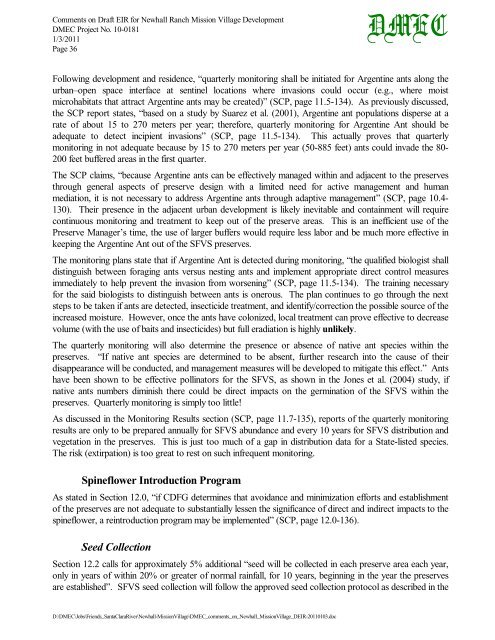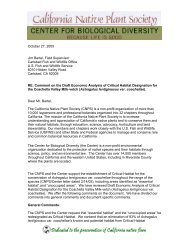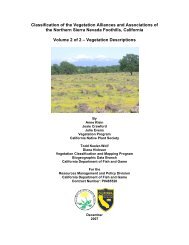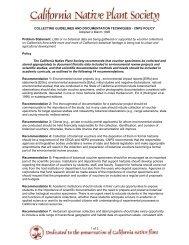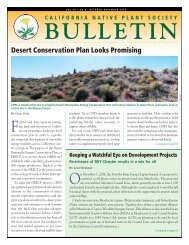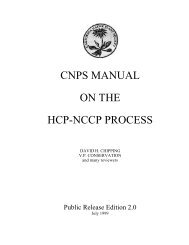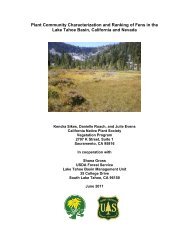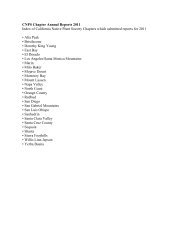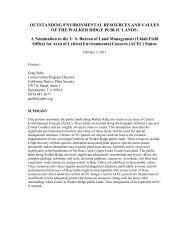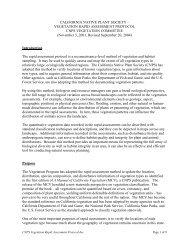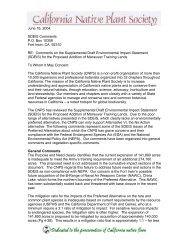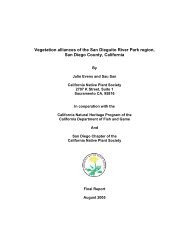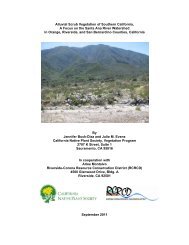David Magney Environmental Consulting - California Native Plant ...
David Magney Environmental Consulting - California Native Plant ...
David Magney Environmental Consulting - California Native Plant ...
Create successful ePaper yourself
Turn your PDF publications into a flip-book with our unique Google optimized e-Paper software.
Comments on Draft EIR for Newhall Ranch Mission Village Development<br />
DMEC Project No. 10-0181<br />
1/3/2011<br />
Page 36<br />
D:\DMEC\Jobs\Friends_SantaClaraRiver\Newhall-MissionVillage\DMEC_comments_on_Newhall_MissionVillage_DEIR-20110103.doc<br />
DMEC<br />
Following development and residence, “quarterly monitoring shall be initiated for Argentine ants along the<br />
urban–open space interface at sentinel locations where invasions could occur (e.g., where moist<br />
microhabitats that attract Argentine ants may be created)” (SCP, page 11.5-134). As previously discussed,<br />
the SCP report states, “based on a study by Suarez et al. (2001), Argentine ant populations disperse at a<br />
rate of about 15 to 270 meters per year; therefore, quarterly monitoring for Argentine Ant should be<br />
adequate to detect incipient invasions” (SCP, page 11.5-134). This actually proves that quarterly<br />
monitoring in not adequate because by 15 to 270 meters per year (50-885 feet) ants could invade the 80-<br />
200 feet buffered areas in the first quarter.<br />
The SCP claims, “because Argentine ants can be effectively managed within and adjacent to the preserves<br />
through general aspects of preserve design with a limited need for active management and human<br />
mediation, it is not necessary to address Argentine ants through adaptive management” (SCP, page 10.4-<br />
130). Their presence in the adjacent urban development is likely inevitable and containment will require<br />
continuous monitoring and treatment to keep out of the preserve areas. This is an inefficient use of the<br />
Preserve Manager’s time, the use of larger buffers would require less labor and be much more effective in<br />
keeping the Argentine Ant out of the SFVS preserves.<br />
The monitoring plans state that if Argentine Ant is detected during monitoring, “the qualified biologist shall<br />
distinguish between foraging ants versus nesting ants and implement appropriate direct control measures<br />
immediately to help prevent the invasion from worsening” (SCP, page 11.5-134). The training necessary<br />
for the said biologists to distinguish between ants is onerous. The plan continues to go through the next<br />
steps to be taken if ants are detected, insecticide treatment, and identify/correction the possible source of the<br />
increased moisture. However, once the ants have colonized, local treatment can prove effective to decrease<br />
volume (with the use of baits and insecticides) but full eradiation is highly unlikely.<br />
The quarterly monitoring will also determine the presence or absence of native ant species within the<br />
preserves. “If native ant species are determined to be absent, further research into the cause of their<br />
disappearance will be conducted, and management measures will be developed to mitigate this effect.” Ants<br />
have been shown to be effective pollinators for the SFVS, as shown in the Jones et al. (2004) study, if<br />
native ants numbers diminish there could be direct impacts on the germination of the SFVS within the<br />
preserves. Quarterly monitoring is simply too little!<br />
As discussed in the Monitoring Results section (SCP, page 11.7-135), reports of the quarterly monitoring<br />
results are only to be prepared annually for SFVS abundance and every 10 years for SFVS distribution and<br />
vegetation in the preserves. This is just too much of a gap in distribution data for a State-listed species.<br />
The risk (extirpation) is too great to rest on such infrequent monitoring.<br />
Spineflower Introduction Program<br />
As stated in Section 12.0, “if CDFG determines that avoidance and minimization efforts and establishment<br />
of the preserves are not adequate to substantially lessen the significance of direct and indirect impacts to the<br />
spineflower, a reintroduction program may be implemented” (SCP, page 12.0-136).<br />
Seed Collection<br />
Section 12.2 calls for approximately 5% additional “seed will be collected in each preserve area each year,<br />
only in years of within 20% or greater of normal rainfall, for 10 years, beginning in the year the preserves<br />
are established”. SFVS seed collection will follow the approved seed collection protocol as described in the


